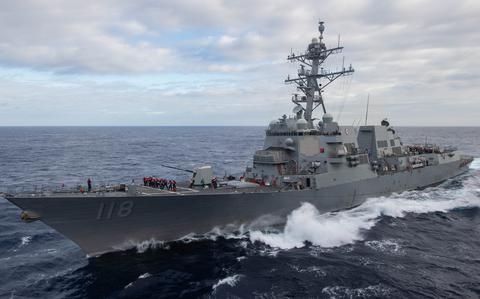The U.S. Navy is starting to enlist individuals who didn’t graduate from high school or get a GED, marking the second time in about a year that the service has opened the door to lower-performing recruits as it struggles to meet enlistment goals.

www.stripes.com
No diploma, no problem: Navy again lowers requirements as it struggles to meet recruitment goals
By
LOLITA C. BALDOR
ASSOCIATED PRESS • January 27, 2024
The Arleigh Burke-class guided-missile destroyer USS Daniel Inouye in the Pacific Ocean on Jan. 19, 2024. (Richard Tinker/U.S. Navy)
WASHINGTON — The U.S. Navy is starting to enlist individuals who didn’t graduate from high school or get a GED, marking the second time in about a year that the service has opened the door to lower-performing recruits as it struggles to meet enlistment goals.
The decision follows a move in December 2022 to bring in a larger number of recruits who score very low on the Armed Services Qualification Test. Both are fairly rare steps that the other military services largely avoid or limit, even though they are all finding it increasingly difficult to attract the dwindling number of young people who can meet the military’s physical, mental and moral standards.
Under the new plan, Navy recruits without an education credential will be able to join as long as they score 50 or above on the qualification test, which is out of 99. The last time the service took individuals without education credentials was in 2000.
“We get thousands of people into our recruiting stations every year that want to join the Navy but do not have an education credential. And we just turn them away,” said Vice Adm. Rick Cheeseman, the Navy’s chief of personnel, in an interview Friday with The Associated Press.
He said that of the more than 2,400 who were turned away last year, as many as 500 of them could score high enough to get in. He said he has already sent an order to his recruiters to start the new expanded effort, adding, “I’m hoping all my recruiters have called all 2,442 of them in the last 72 hours, and we’ll see how it goes. … We’ll try to get some test takers this weekend.”
In the wake of the COVID-19 pandemic, the services have faced significant enlistment challenges. COVID-19 forced the military to shut down recruiting stations, and they were closed out of high schools and many public fairs of events where they historically found success reaching prospective candidates.
But even as things opened up, the military struggled to compete with higher-paying businesses in the tight job market, particularly as companies began to offer the types of benefits — such as college funding — that had often made the military a popular choice. Those economic problems were only exacerbated by the sharp political divide in the country and young people’s fears of being killed or injured going to war.
Last fiscal year, which ended Sept. 30, the Navy, Army and Air Force all failed to meet their recruitment goals, while the Marine Corps and the tiny Space Force met their targets. The previous fiscal year, the Army fell 15,000 short of its enlistment goal of 60,000, and the other services had to dig into the pools of delayed entry candidates in order to meet their recruiting numbers.
Last year, the Navy’s enlistment goal was 37,700, but the service brought in just 31,834. This year, Cheeseman said, he set the goal higher — at 40,600. The total size of the Navy for 2024 is set at 337,800.
“I need these sailors. So it’s a stretch goal. We’re telling our recruiters to go get 40,600 people to join the Navy,” he said. “We don’t fully expect to get that many. But we’re going for it.”
The other services have largely balked at such changes.
The Navy is the only service that enlists anyone considered a “category four” recruit, meaning they scored 30 or less on the qualification test. The service expanded the number of those category four recruits arguing that a number of jobs — such as cook or boatswain mate — don’t require an overall high test score, as long as they meet the job standards.
The Army will only take those lowest scoring candidates into their so-called Future Soldier Prep Course, which gives them weeks of instruction and the opportunity to increase their score in order to make the grade and enlist. The Navy allows low-scoring recruits to go through its Future Sailor Prep Course but doesn’t require an increased score to enlist.
In addition, the Army and Marine Corps require a high school diploma or GED equivalent, and the Air Force said it will only take recruits without a diploma if they score a 65 or higher on the qualification test. Those numbers are very small — just 110 of the nearly 26,900 Air Force recruits brought in last year, either had a GED or no education credential at all.
Other services cite concerns that lower-performing recruits may be more likely to wash out of boot camp or could present more disciplinary problems over time.
Cheeseman said he believes the biggest risk is that they do fail boot camp at higher rates, but he said the difference hasn’t been significant so far for the low-scoring recruits brought in last year. Overall, 11.4% of those recruits didn’t finish boot camp, compared to less than 6.5% of the high-scoring sailors.
He said Navy leaders had been talking about opening up enlistment to those without high school credentials for a while in an effort to expand the pool of potential sailors.
“We just finally decided, okay, let’s go,” he said, adding that the service was looking for other ways to reach untapped talent. “My argument for accepting that risk is that we have capacity of boot camp. We’re not filling the seats. So I’m willing to take a risk.”



